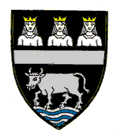Document Contents

The early history of the cathedral established for the diocese of Oxford created in 1542 was complex. On the first foundation of the see, in letters patent dated 1 September 1542, the see was established in the former abbey at Oseney with the former prior, Robert King, as bishop. The cathedral was established with a dean and six canons nominated by the king (perhaps reflecting the fact that the abbey had boasted seven sets of ‘lodgings’ [horn1996: 69]).
Only three years later, however, these arrangements were overturned. Cardinal Wolsey’s scheme for a great college on the site of the former priory of St Frideswide in Oxford had come to grief with his fall from favour, but in 1542 the intended ‘Cardinal College’ was refounded as King Henry VIII’s College, with a dean and twelve canons, eight priests, a clerk and twelve honest paupers. On 20 May 1545 the dean of the college surrendered it to the crown, and on the same day a similar surrender was effected by the bishop of Oxford for his cathedral. Just over a year later on 4 November 1546 the king established the ‘Ecclesia Christi Cathedralis Oxon’, amalgamating the two institutions on the site of the college (horn1996: 70). The new letters patent established a dean to be both head of the cathedral chapter and of the college, which was also given renewed life; there were also to be eight canons, appointed by the crown. If the cathedral establishment was thus more impressive than at Oseney, this was not the case with the cathedral itself, as the abbey, almost all trace of which has now vanished, was a much bigger building than the priory church. Curiously, and perhaps as a result of Henry VIII’s death early in 1547, no statutes were issued for the cathedral, and as late as 1837 the chapter had to base their claim to regulatory powers on the charter of endowment.
The close relationship between the cathedral and university embedded in its refoundation was reinforced when in 1605 and 1630 the regius professorships of Divinity and Hebrew respectively were annexed to two of the canonries.
Like all cathedrals Oxford’s suffered its fair share of trials in the seventeenth century, although the presence of the university again gave these a distinctive character. Charles I made the city his headquarters during the Civil War, and took up residence at Christ Church. When parliament abolished deans and chapters, the dual role of the Christ Church establishment meant that officers with these names continued to discharge their roles as fellows of the college. The dean and seven canons in post in April 1648 were ejected and replaced with individuals more in sympathy with the new regime. At the Restoration in turn, the dean and all but one of the incumbent canons were deprived. A futher hiccup in the succession of cathedral offices ensued when James II appointed the Roman Catholic John Massey dean in 1686; Massey, whose appointment was the subject of protest by the subdean and canons, fled to Douai in 1689, and when Henry Aldrich was presented by William and Mary in 1689, he was described as a successor to Massey’s predecessor, John Fell.
Joyce Horn notes the frequent presence of bishops of other dioceses among the eighteenth-century canons of Oxford. The deanery itself was often held by the bishop of Bristol. (horn1996: 71).
Describing the state of Christ Church presented the authors of the report on ecclesiastical duties and revenues published in 1835 with considerable difficulties, as it proved impossible to disentangle the finances of college and cathedral. They returned the average gross yearly income of the dean and chapter as £25,899, outstripping that of Canterbury and surpassed only by Durham among the cathedrals. However the net income was only £12,203, still one of the highest figures, but less than Canterbury’s. The finances of the individual offices in the cathedral were complex: for example, the dean was stated to receive a wage of £133 6s. 8d., £10 focalia, half of the rent of the college meadow (£125), and a fifth of the sum divided between the canons (total £12,547). The canons had no separate individual revenues.

Patronage
The dean and chapter of Christ Church had no fewer than 93 livings in their gift. Only seventeen of these, however, were in the Oxford diocese: Benson, Binsey, Blackbourton, Brizenorton, Caversham, Cassington, Chalgrove with Berrick, Cowley, Drayton, Oxford St Mary Magdalen and St Thomas, Pirton, Southstoke, Spelsbury, Stratton Audley, Wendlebury and Westwell. The others were widely dispersed. There were thirteen livings in Lincoln: Ashenden, Great Bowden, Cowpull, Dorton, Flitton with Silsoe, Hillesden, Lathbury, Market Harborough, Slapton, Tring with Wigginton, and Willin. There were also thirteen in Gloucester: Batsford, Bladington, Little Compton, Down Ampney, Iron Acton, North Nibley, Swell Inferior, Temple Guiting, Thornbury, Turkdean with Aldsworth, Twyning, and Wotton under Edge. In York there were ten: Bramham, Broughton, Carleton, Featherstone, Kildwick, North Ottrington, Preston, Skipton, Thornton-le-Street, and Wath; in Salisbury nine: Ardington, Charlton, Chippenham, East Garston, East Hampstead, East Lavington, Maiden Bradley, Marcham and Semley. The chapter held eight livings in Peterborough: Badbey with Newnham, Daventry, Easton Mawdit, Flower, Harringworth, Ravensthorpe and Staverton; in Worcester six – Badsey, Hampton, North and South Littleton, and Wickhamford; in Chester five – Great Budworth, Daresbury, Frodsham, Kirkham, and Runcorn. The remaining livings were as follows: Batheaston, Midsomer Norton ands Odcombe (Bath and Wells), Hawkhurst (Canterbury), Shering (London), Staunton on Wye and Wentnor (Hereford), Swanton Novers with Woodnorton (Norwich), Great Torrington and St Tudye (Exeter) and Tolpuddle (Bristol).